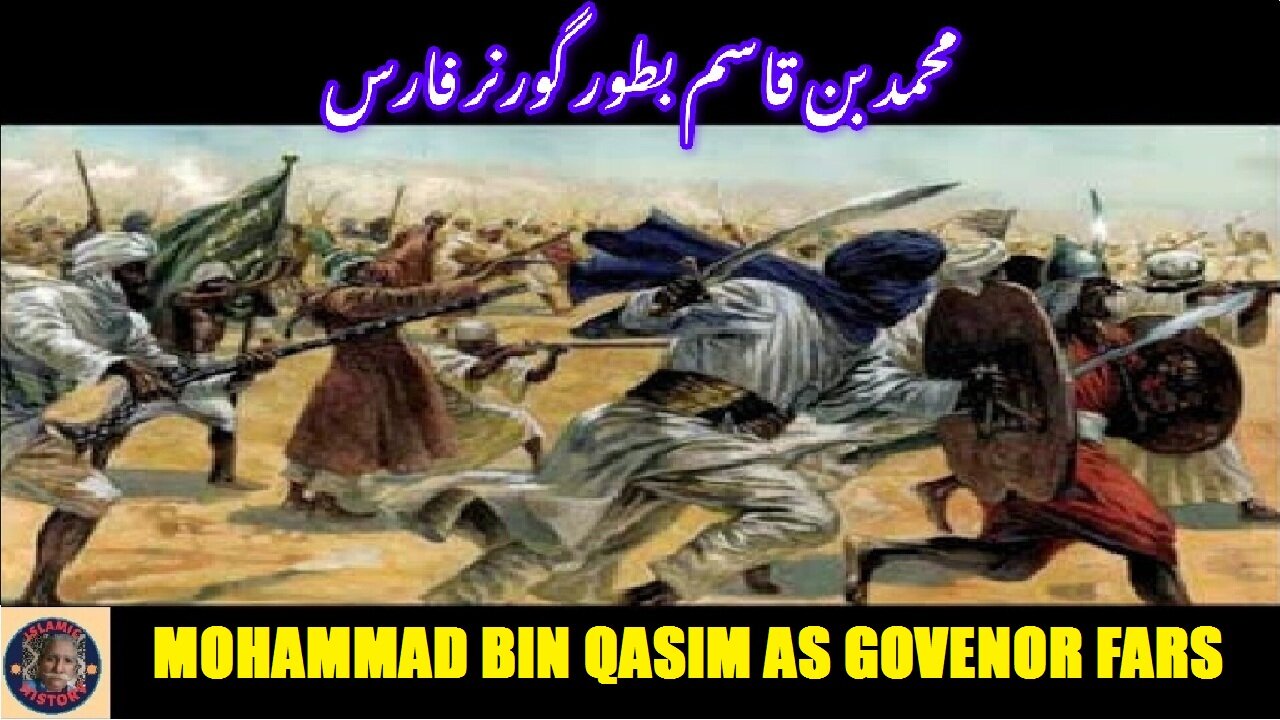Premium Only Content

Muhammad ibn al-Qasim as a Governor of Fars | محمد بن القاسم فارس کے گورنر
@islamichistory813 #MuhammadIbnAlQasim #History #IslamicGovernance
Muhammad ibn al-Qasim as a Governor of Fars
Dekhti Aankhooon aur sountay kaanoon ko Asslamoalaikum, sisters, brothers friends and elders, in this islamic warriors leaders informative video, we are describing the significant role of Muhammad ibn al-Qasim as the Governor of Fars. We are describing his administrative strategies, military achievements, and the cultural impact he had during his tenure, we provide a comprehensive overview of his contributions to the region. Please be with us and watch complete video upto end as we are describing the historical context and legacy of this influential figure in Islamic history.
Muhammad ibn al-Qasim's first assignment was in the province Fars in modern Iran, where he was asked to subjugate a group of Kurds. After the successful completion of the mission, he was appointed as the governor of Fars. He likely succeeded his uncle Muhammad ibn Yusuf al-Thaqafi, a brother of al-Hajjaj, who was previously a governor. The city of Shiraz is said to have been revived by Muhammad ibn al-Qasim. He built a royal villa in the city and a military camp at a short distance from it. He was also given the task of subjugating the area to the south of Shiraz, and the distant area of Jurjan near the Caspian Sea.
Fars might have also had at this time some of the rebels leftover from the revolt of Ibn al-Ash'ath, which almost brought down the rule of al-Hajjaj. An aged supporter of rebels and a Shia notable of the time, a disciple of the companion of Jabir ibn Abd Allah al-Ansari and a famous narrator of Hadith, Atiyya ibn Sa'd al-Awfi was arrested by Muhammad ibn al-Qasim on the orders of Al-Hajjaj and demanded that he curse Ali on the threat of punishment. Atiyya refused to curse Ali and was punished. While Maclean doesn't give the details of the punishment, early historians like Ibn Hajar Al-asqalani and Tabari record that he was flogged by 400 lashes and his head and beard shaved for humiliation and that he fled to Khurasan and returned to Iraq after the ruler had been changed.
Background on Sindh
The connection between the Hindu Sind and Islam was established by the initial Muslim missions during the Rashidun Caliphate. Hakim ibn Jabala al-Abdi, who attacked Makran in the year 649 AD, was an early partisan of Ali ibn Abu Talib. During the caliphate of Ali, many Jats of Sindh had come under influence of Islam and some even participated in the Battle of Camel and died fighting for Ali. Harith ibn Murrah al-Abdi and Sayfi ibn Fasayl' al-Shaybani, both officers of Ali's army, attacked Makran in the year 658. Sayfi was one of the seven shias who were beheaded alongside Hujr ibn Adi al-Kindi in 660 AD near Damascus. Under the Umayyads (661–750 AD), many Shias sought asylum in the region of Sindh, to live in relative peace in the remote area. Ziyad Hindi is one of those refugees.
According to Wink, Umayyad interest in the region was galvanised by the operation of the Meds (a tribe of Scythians living in Sindh) and others. The Meds had engaged in piracy on Sassanid shipping in the past, from the mouth of the Tigris to the Sri Lankan coast, in their bawarij and now were able to prey on Arab shipping from their bases at Kutch, Debal and Kathiawar.[26] At the time, Sindh was the wild frontier region of al-Hind, inhabited mostly by semi-nomadic tribes whose activities disturbed much of the Western Indian Ocean. Muslim sources insist that it was these persistent activities along increasingly important Indian trade routes by Debal pirates and others which forced the Arabs to subjugate the area, in order to control the seaports and maritime routes of which Sindh was the nucleus, as well as, the overland passage. During Hajjaj's governorship, the Meds of Debal in one of their raids had kidnapped Muslim women travelling from Sri Lanka to Arabia, thus providing grounds to the rising power of the Umayyad Caliphate that enabled them to gain a foothold in the Makran, Balochistan and Sindh regions
Also cited as a reason for this campaign was the policy of providing refuge to Sassanids fleeing the Arab advance and to Arab rebels from the Umayyad consolidation of their rule.[clarification needed]
These Arabs were imprisoned later on by Governor Deebal Partaab Raye. A letter written by an Arab girl named Nahed who escaped from the prison of Partab Raye asked Hajjaj Bin Yusuf for help. When Hajjaj asked Dahir for the release of prisoners and compensation, the latter refused on the ground that he had no control over those. Al-Hajjaj sent Muhammad ibn al-Qasim for action against the Sindh in 711. [citation needed]
The mawali (new non-Arab converts) who were usually allied with Al-Hajjaj's political opponents and thus were frequently forced to participate in battles on the frontier of the Umayyad Caliphate, such as Kabul, Sindh and Transoxania. An actual push into the region had been out of favour as an Arab policy since the time of the Rashidun Caliph Umar bin Khattab, who upon receipt of reports of it being an inhospitable and poor land, had stopped further expeditionary ventures into the region
so sisters brothers friends and elders, tomorow we are going to described How Muhammad ibn al-Qasim Conquest of valley of Sindh?. Allah hafiz
======================================
-
 15:14
15:14
ISLAMIC HISTORY
1 day agoIslamic History Episode 250 Qarmatian rebellion in Iraq عراق میں قرامطہ کی شورش
2 -
 19:54
19:54
Forrest Galante
4 days agoPrivate Tour Of America's Best Marine Animal Facility
100K12 -
 LIVE
LIVE
Lofi Girl
2 years agoSynthwave Radio 🌌 - beats to chill/game to
165 watching -
 2:19:50
2:19:50
Akademiks
4 hours agoDrake Lawsuit Dismissed by Federal Judge. What does it Mean.... for the boy.
122K5 -
 1:01:38
1:01:38
DeVory Darkins
13 hours ago $47.31 earnedSchumer suffers humiliation as critics applaud Trump's historic peace deal with Tim Pool
106K51 -
 56:09
56:09
Steven Crowder
18 hours agoBlack Fatigue is Real and I Told Them Why | Black & White on the Gray Issues
512K2.19K -
 2:05:36
2:05:36
Inverted World Live
10 hours agoSaint's Tomb Opened for First Time in 800 Years for Ancient Ritual | Ep. 121
98.2K16 -
 2:43:30
2:43:30
TimcastIRL
8 hours agoNY AG Indicted For FRAUD, Faces 30 Years In Prison, $1 MILLION FINE | Timcast IRL
223K99 -
 1:09:16
1:09:16
Man in America
18 hours agomRNA 2.0: This Frightening Tech Can Target Your BRAIN Using Biological Post Codes
57.9K21 -
 1:28:31
1:28:31
The Charlie Kirk Show
7 hours agoTHOUGHTCRIME Ep. 100 — Turning Point Halftime? Potatoes and Katie Porter? Hasan the Dog Shocker?
116K58